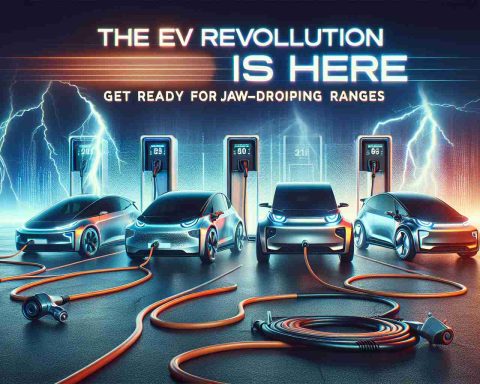China’s Electric Vehicle Surge
In the first half of 2024, China spearheaded a remarkable transformation in the electric vehicle (EV) market, contributing to nearly 80% of the global sales growth. According to a recent report from the International Energy Agency (IEA), sales jumped from over 3 million in 2023 to more than 4 million, showcasing an impressive demand for environmentally friendly vehicles.
Global Impact of EVs
Worldwide, EV sales surpassed 7 million units in the same period, marking a 25% increase compared to the prior year. By the end of 2024, EVs are anticipated to constitute 5% of the total car fleet globally. While China led the charge, regions such as Brazil, Indonesia, and Mexico also displayed notable growth, with a more than 10% increase in sales. In contrast, European markets experienced diverse outcomes; while Germany witnessed a decline, the UK achieved a 15% increase in EV sales.
The Rise of Plug-in Hybrids
Another significant trend identified in the report is the surge in plug-in hybrid electric vehicles (PHEVs), which accounted for over 35% of total sales this year. China saw PHEV sales skyrocket by 70%, propelled by range-extended electric vehicles offering superior driving ranges. In the US, PHEV sales rose by 25%, while traditional battery electric vehicle sales nudged up by only 5%.
The IEA underscores the need for enhanced recharging infrastructure to alleviate concerns about driving range and sustain future growth in the EV sector.
The Future of Electric Vehicles: A Deep Dive into Market Trends and Innovations
China’s Electric Vehicle Surge
The electric vehicle (EV) market is undergoing a radical transformation, with China at the forefront of this evolution. In the first half of 2024, China was responsible for nearly 80% of the global sales growth in the EV sector. According to the latest report from the International Energy Agency (IEA), global sales increased from over 3 million units in 2023 to more than 4 million in 2024. This dynamic shift highlights an escalating demand for environmentally friendly transportation solutions.
Global Impact of EVs
Globally, EV sales surpassed 7 million units in the same timeframe, representing a significant 25% growth compared to the previous year. By the end of 2024, it is projected that EVs will make up 5% of the total car fleet worldwide. While China’s leadership in the market is unmistakable, other regions are also experiencing considerable growth. Countries like Brazil, Indonesia, and Mexico recorded more than a 10% uptick in sales, highlighting the global shift toward electric mobility.
In contrast, the European market displayed mixed results. Germany saw a downturn in EV sales, while the UK experienced a 15% increase. This disparity illustrates the varying degrees of consumer adoption and market maturity across different regions.
The Rise of Plug-in Hybrids
One of the most notable trends in 2024 is the rise of plug-in hybrid electric vehicles (PHEVs), which made up over 35% of total EV sales. In China, PHEV sales experienced an astonishing 70% growth, driven by the popularity of range-extended electric vehicles that address consumer concerns regarding driving range limitations. In the United States, PHEV sales increased by 25%, while traditional battery electric vehicle sales saw a modest growth of only 5%.
Enhancing Infrastructure for Sustainable Growth
The IEA emphasizes that the expansion of recharging infrastructure is critical for alleviating consumer concerns about driving range and supporting future growth in the EV sector. As charging stations become more widespread and accessible, the market is expected to expand even further, paving the way for more consumers to transition to electric vehicles.
Pros and Cons of Electric Vehicles
Pros:
– Environmental Benefits: EVs produce no tailpipe emissions, reducing air pollution.
– Lower Operating Costs: Electricity is often cheaper than gasoline; maintenance costs are generally lower.
– Government Incentives: Many governments offer tax breaks, rebates, and other incentives for buying EVs.
Cons:
– Limited Range: Many EVs still have a shorter range compared to traditional vehicles.
– Charging Time: Charging can take longer than refueling a gasoline car.
– Initial Cost: The upfront cost of EVs is often higher than that of conventional cars, although this is changing as technology evolves.
Future Trends and Innovations
1. Battery Technology Enhancements: Innovations in solid-state and lithium-silicon batteries are expected to further improve the range and efficiency of EVs.
2. Smart Charging Solutions: The introduction of smart grids and vehicle-to-grid technology will optimize energy use and potentially allow EVs to contribute to power supply.
3. Diverse Vehicle Offerings: As manufacturers expand their lineups, consumers will have more choices, including SUVs and trucks built on electric platforms.
Conclusion
As the EV market continues to evolve, driven largely by China’s impressive growth and innovations in vehicle technology, the world is moving towards a more sustainable future. Understanding the trends, advantages, and challenges associated with electric vehicles can facilitate more informed decisions for consumers and policymakers alike.
For more details on the current trends in electric vehicles, visit IEA.








